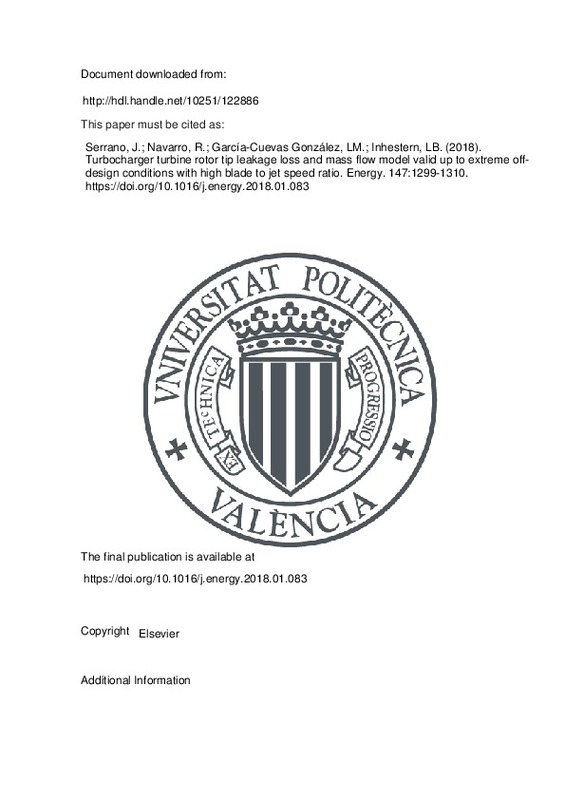JavaScript is disabled for your browser. Some features of this site may not work without it.
Buscar en RiuNet
Listar
Mi cuenta
Estadísticas
Ayuda RiuNet
Admin. UPV
Turbocharger turbine rotor tip leakage loss and mass flow model valid up to extreme off-design conditions with high blade to jet speed ratio
Mostrar el registro sencillo del ítem
Ficheros en el ítem
| dc.contributor.author | Serrano, J.R.
|
es_ES |
| dc.contributor.author | Navarro, Roberto
|
es_ES |
| dc.contributor.author | García-Cuevas González, Luis Miguel
|
es_ES |
| dc.contributor.author | Inhestern, Lukas Benjamin
|
es_ES |
| dc.date.accessioned | 2019-06-28T20:04:47Z | |
| dc.date.available | 2019-06-28T20:04:47Z | |
| dc.date.issued | 2018 | es_ES |
| dc.identifier.issn | 0360-5442 | es_ES |
| dc.identifier.uri | http://hdl.handle.net/10251/122886 | |
| dc.description.abstract | [EN] Due to the power consumption restriction of the turbocharger compressor, common turbine maps are rather narrow. To extrapolate them, reliable physical submodels are needed that are valid for broad ranges. Plenty of research has been done referring to tip leakage losses in axial and traditional radial turbomachinery. However, less effort has been put into the tip leakage analysis of radial turbocharger turbines, whose characteristics including high rotational speed and geometry are rather different. Commonly developed tip leakage loss models in radial turbines are mainly based on correlations with the rotational speed, while in axial turbomachinery they are mainly based on blade loading assumptions. Wide range computational fluid dynamics (CFD) data of a medium sized automotive turbine have been used to analyze tip leakage mass flow under extremely diverse running conditions. To be able to fit a model in a broad range of the map, blade loading and rotational speed have to be considered. A novel tip clearance model has been derived from the Navier Stokes Equations. The model owns a dependency on the rotational speed and the blade loading. With this approach CFD data have been fitted in a very good quality to model the tip leakage mass flow rate and tip leakage losses. | es_ES |
| dc.description.sponsorship | The work has been partially supported by FEDER and the Spanish Ministry of Economy and Competitiveness through grant number TRA2016-79185-R. | es_ES |
| dc.language | Inglés | es_ES |
| dc.publisher | Elsevier | es_ES |
| dc.relation.ispartof | Energy | es_ES |
| dc.rights | Reconocimiento - No comercial - Sin obra derivada (by-nc-nd) | es_ES |
| dc.subject | Radial turbine model | es_ES |
| dc.subject | Tip leakage | es_ES |
| dc.subject | Off-design | es_ES |
| dc.subject | High BSR | es_ES |
| dc.subject | CFD | es_ES |
| dc.subject | Wide map | es_ES |
| dc.subject.classification | INGENIERIA AEROESPACIAL | es_ES |
| dc.subject.classification | MAQUINAS Y MOTORES TERMICOS | es_ES |
| dc.title | Turbocharger turbine rotor tip leakage loss and mass flow model valid up to extreme off-design conditions with high blade to jet speed ratio | es_ES |
| dc.type | Artículo | es_ES |
| dc.identifier.doi | 10.1016/j.energy.2018.01.083 | es_ES |
| dc.relation.projectID | info:eu-repo/grantAgreement/MINECO//TRA2016-79185-R/ES/DESARROLLO DE HERRAMIENTAS EXPERIMENTALES Y COMPUTACIONALES PARA LA CARACTERIZACION DE SISTEMAS DE POST-TRATAMIENTO DE GASES DE ESCAPE EN MOTORES DE ENCENDIDO POR COMPRESION/ | es_ES |
| dc.rights.accessRights | Abierto | es_ES |
| dc.contributor.affiliation | Universitat Politècnica de València. Departamento de Máquinas y Motores Térmicos - Departament de Màquines i Motors Tèrmics | es_ES |
| dc.description.bibliographicCitation | Serrano, J.; Navarro, R.; García-Cuevas González, LM.; Inhestern, LB. (2018). Turbocharger turbine rotor tip leakage loss and mass flow model valid up to extreme off-design conditions with high blade to jet speed ratio. Energy. 147:1299-1310. https://doi.org/10.1016/j.energy.2018.01.083 | es_ES |
| dc.description.accrualMethod | S | es_ES |
| dc.relation.publisherversion | https://doi.org/10.1016/j.energy.2018.01.083 | es_ES |
| dc.description.upvformatpinicio | 1299 | es_ES |
| dc.description.upvformatpfin | 1310 | es_ES |
| dc.type.version | info:eu-repo/semantics/publishedVersion | es_ES |
| dc.description.volume | 147 | es_ES |
| dc.relation.pasarela | S\355379 | es_ES |
| dc.contributor.funder | Ministerio de Economía y Competitividad | es_ES |







![[Cerrado]](/themes/UPV/images/candado.png)

